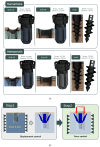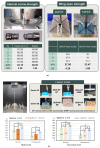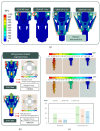Short Expandable-Wing Suture Anchor for Osteoporotic and Small Bone Fixation: Validation in a 3D-Printed Coracoclavicular Reconstruction Model
- PMID: 41149725
- PMCID: PMC12565743
- DOI: 10.3390/jfb16100379
Short Expandable-Wing Suture Anchor for Osteoporotic and Small Bone Fixation: Validation in a 3D-Printed Coracoclavicular Reconstruction Model
Abstract
Suture anchors are widely used for tendon and ligament repair, but their fixation strength is compromised in osteoporotic bone and limited bone volume such as the coracoid process. Existing designs are prone to penetration and insufficient cortical engagement under such conditions. In this study, we developed a novel short expandable-wing (SEW) suture anchor (Ti6Al4V) designed to enhance pull-out resistance through a deployable wing mechanism that locks directly against the cortical bone. Finite element analysis based on CT-derived bone material properties demonstrated reduced intra-bone displacement and improved load transfer with the SEW compared to conventional anchors. Mechanical testing using matched artificial bone surrogates (N = 3 per group) demonstrated significantly higher static pull-out strength in both normal (581 N) and osteoporotic bone (377 N) relative to controls (p < 0.05). Although the sample size was limited, results were consistent and statistically significant. After cyclic loading, SEW anchor fixation strength increased by 25-56%. In a 3D-printed anatomical coracoclavicular ligament reconstruction model, the SEW anchor provided nearly double the fixation strength of the hook plate, underscoring its superior stability under high-demand clinical conditions. This straightforward implantation protocol-requiring only a 5 mm drill hole without tapping, followed by direct insertion and knob-driven wing deployment-facilitates seamless integration into existing surgical workflows. Overall, the SEW anchor addresses key limitations of existing anchor designs in small bone volume and osteoporotic environments, demonstrating strong potential for clinical translation.
Keywords: 3D-printing; coracoclavicular; osteoporotic; pull-out; suture anchor.
Conflict of interest statement
The authors declare no conflict of interest in this research.
Figures







References
-
- Chaudhry S., Dehne K., Hussain F. A review of suture anchors. Orthop. Trauma. 2019;33:263–270. doi: 10.1016/j.mporth.2016.12.001. - DOI
-
- Braunstein V., Ockert B., Windolf M., Sprecher C.M., Mutschler W., Imhoff A., Postl L.K.L., Biberthaler P., Kirchhoff C. Increasing pullout strength of suture anchors in osteoporotic bone using augmentation—A cadaver study. Clin. Biomech. 2015;30:243–247. doi: 10.1016/j.clinbiomech.2015.02.002. - DOI - PubMed
-
- Yang Y.S., Shih C.A., Fang C.J., Huang T.T., Hsu K.L., Kuan F.C., Su W.R., Hong C.K. Biomechanical comparison of different suture anchors used in rotator cuff repair surgery-all-suture anchors are equivalent to other suture anchors: A systematic review and network meta-analysis. J. Exp. Orthop. 2023;10:45. doi: 10.1186/s40634-023-00608-w. - DOI - PMC - PubMed
Grants and funding
LinkOut - more resources
Full Text Sources

